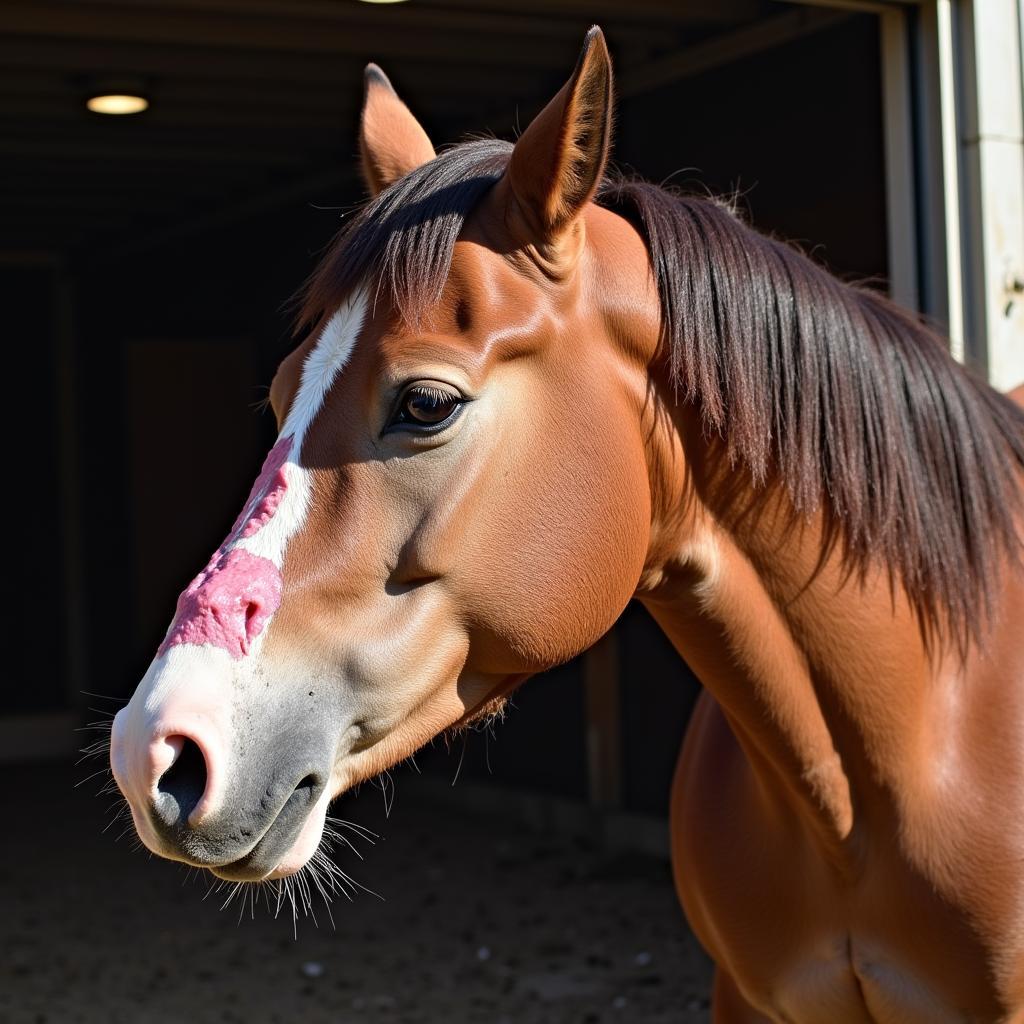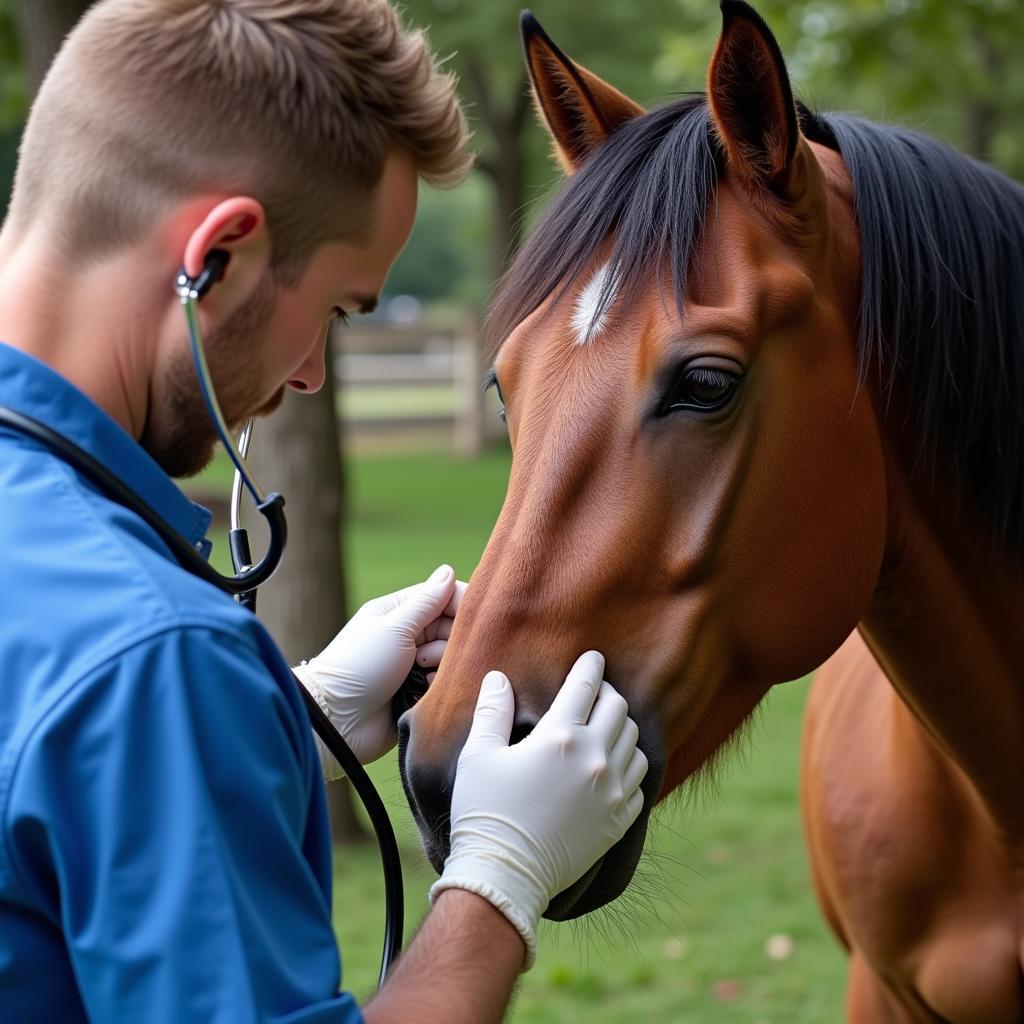Big Head Disease In Horses, more formally known as nutritional secondary hyperparathyroidism, is a serious condition that affects their skeletal system. It occurs due to an imbalance of calcium and phosphorus in the horse’s diet, leading to the body leaching calcium from the bones. This can result in a range of skeletal deformities, including an enlarged head, which gives the disease its common name.
Understanding the Causes of Big Head Disease
The primary cause of big head disease is a dietary deficiency of calcium or an imbalance in the calcium-to-phosphorus ratio. Horses require a specific ratio of these minerals for healthy bone development and maintenance.
Here’s a breakdown of common causes:
- Diets High in Phosphorus: Feeding horses diets high in grain and bran, which are rich in phosphorus, without adequate calcium supplementation can disrupt the calcium-phosphorus balance.
- Grazing on High-Oxalate Pastures: Some pastures contain plants high in oxalates, which can bind to calcium in the digestive tract and prevent its absorption.
- Inadequate Vitamin D: Vitamin D plays a crucial role in calcium absorption. Limited sunlight exposure or dietary deficiencies can contribute to the development of big head disease.
Recognizing the Symptoms
Big head disease can manifest in a variety of ways, and the signs can be subtle in the early stages.
Look out for these symptoms:
- Enlarged Head: As the name suggests, an increase in the size of the horse’s head, particularly around the facial bones, is a key symptom.
- Lameness and Stiffness: The horse may exhibit lameness, particularly in the forelimbs, due to pain and weakness in the bones.
- Shifting Lameness: Lameness might shift from one leg to another as the disease progresses.
- Swollen Bones: Swelling, especially around the face, jaw, and lower limbs, is often observed.
- Reluctance to Move: Horses with big head disease may be reluctant to move or exercise due to pain and discomfort.
- Loss of Appetite and Weight Loss: These general signs of illness can also accompany big head disease.
 Horse Showing Symptoms of Big Head Disease
Horse Showing Symptoms of Big Head Disease
Diagnosing and Treating Big Head Disease
If you suspect your horse might have big head disease, it’s essential to contact your veterinarian immediately. Early diagnosis and intervention are crucial for managing the condition effectively.
- Diagnosis: Your vet will perform a thorough physical exam and may recommend blood tests to assess calcium and phosphorus levels. X-rays can reveal bone density and identify any skeletal abnormalities.
- Treatment: Treatment typically involves dietary modifications to correct the calcium-phosphorus imbalance. This might include:
- Switching to a low-phosphorus diet.
- Supplementing with calcium and vitamin D.
- Providing access to good quality hay as a primary source of forage.
 Veterinarian Examining Horse for Big Head
Veterinarian Examining Horse for Big Head
The Importance of Prevention
Preventing big head disease is far easier than treating it. Here are some key preventative measures:
- Balanced Diet: Ensure your horse receives a balanced diet with the correct calcium-to-phosphorus ratio. Consult with an equine nutritionist to formulate a suitable feeding plan.
- Quality Hay: Offer good quality hay as the foundation of your horse’s diet. Hay is naturally high in calcium and low in phosphorus.
- Limited Grain: Limit grain intake, especially those high in phosphorus, and provide it only as a supplement when necessary.
- Mineral Supplements: Use a balanced mineral supplement that includes calcium and vitamin D, particularly if your horse’s diet is lacking in these nutrients.
Living with Big Head Disease
While the skeletal changes associated with big head disease are often irreversible, early diagnosis and proper management can significantly improve the horse’s quality of life and prevent further bone deterioration.
“Early intervention is key when it comes to big head disease,” says Dr. Emily Carter, DVM, an equine veterinarian specializing in nutrition. “By addressing the dietary imbalances and providing appropriate care, we can help horses with this condition live more comfortable lives.”
 Horses Grazing on a Healthy Pasture
Horses Grazing on a Healthy Pasture
Big Head Disease FAQ
1. Can big head disease be cured?
While the skeletal changes caused by big head disease are often irreversible, early diagnosis and proper management can prevent further bone deterioration and improve the horse’s quality of life.
2. How long does it take for a horse to recover from big head disease?
Recovery time varies depending on the severity of the condition and how early it’s diagnosed. With appropriate treatment, some horses may show improvement within a few months, while others may require lifelong management.
3. Is big head disease contagious?
No, big head disease is not contagious. It’s a nutritional disorder caused by dietary imbalances.
4. What types of horses are most susceptible to big head disease?
Young, growing horses and pregnant or lactating mares are more susceptible to big head disease as they have higher calcium requirements.
5. How can I test my horse’s hay for calcium and phosphorus levels?
Contact your local agricultural extension office or a reputable equine nutritionist. They can guide you on getting your hay analyzed for its nutritional content.
Need More Help?
If you have any concerns about big head disease or your horse’s health, please don’t hesitate to contact us. Our dedicated team at Justus Horses USA is available 24/7 to provide guidance and support. Call us at 0772127271, email us at [email protected], or visit our facility at QGM2+WX2, Vị Trung, Vị Thuỷ, Hậu Giang, Việt Nam.